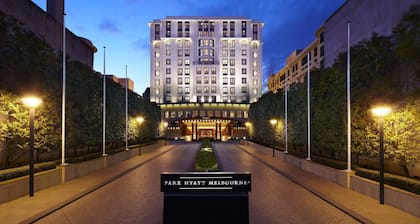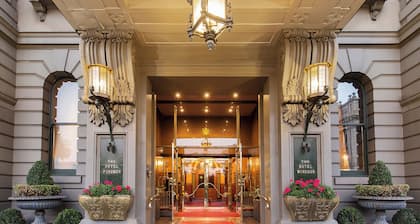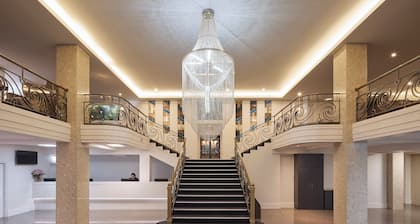Hotels & Accommodation near St Patrick's Cathedral
More than just hotels
Apartments, cabins, holiday rentals and more, plus millions of reviews from Aussie & Kiwi travellers
Flexibility matters
24/7 support, so you can book with confidence
Unlock member prices with Mates Rates
You could save 10% or more on over 100,000 hotels right now.
Check availability on hotels close to St Patrick's Cathedral
Top hotels near St Patrick's Cathedral

Park Hyatt Melbourne

The Hotel Windsor

Le Méridien Melbourne

Next Hotel Melbourne, Curio Collection by Hilton

Stamford Plaza Melbourne

Brady Hotels Jones Lane

Hotel Grand Chancellor Melbourne

Grand Hyatt Melbourne

The Victoria Hotel Melbourne

The Langham, Melbourne

Radisson on Flagstaff Gardens Melbourne
Hotels Near St Patrick's Cathedral
Location, location, location—the mantra is as true in travel as it is in real estate. If you've ever stayed in the boonies, trekked in to see the sights or attend that conference, and trekked out again at the end of a long day or an even longer night, you know exactly what we're talking about. You know that staying in one of the hotels close to St Patrick's Cathedral will put you in the middle of the action, and that there's no better place to be when you're away from home. Why miss hours of sightseeing or precious sleep while fellow tourists or colleagues live it up in the destination you'd been waiting so long to see?
But never fear, dear traveller: St Patrick's Cathedral accommodation won’t break the bank. With Wotif bringing you the best deals in travel, you can book accommodation near St Patrick's Cathedral without blowing your budget, and the money you'll save by snagging that central location at a cheap rate will pay you back in spades. Explore the neighbourhood. Hang with the locals. Let the hotel concierge recommend the best "extras" you denied yourself last time you travelled—that great local restaurant or bar, the expert-guided tour, or the local haunt tourists don't usually know about.
And between adventures, hang out at a great hotel with all the amenities you expect when you travel. The choice is yours, and Wotif is here to help.
St Patrick's Cathedral hotels essential information
Accommodation | 5,446 hotels |
|---|---|
Lowest Price | AU$112 |
Highest Price | AU$327 |
Popular hotels | The Langham, Melbourne, Grand Hyatt Melbourne, The Victoria Hotel Melbourne, Hotel Grand Chancellor Melbourne, Stamford Plaza Melbourne, Next Hotel Melbourne, Curio Collection by Hilton, Park Hyatt Melbourne, Radisson on Flagstaff Gardens Melbourne, The Hotel Windsor, Atlantis Hotel, Melbourne, Le Méridien Melbourne, Brady Hotels Jones Lane |
New reviews! Best hotels in St Patrick's Cathedral

More Destinations
- Hotels near Supreme Court of Victoria
- Apartment Hotels in Docklands
- Docklands Hotels
- Hotels near Flinders Street Station
- Hotels near Melbourne City Baths
- Hotels near Bourke Street Mall
- Hotels near Collins Street
- B&B in Melbourne
- Cabin Rentals in Melbourne
- Caravan Parks in Melbourne
- Cottages in Melbourne
- Holiday Homes in Melbourne
- Hostels in Melbourne
- Alh Group Hotels in Melbourne
- Accor Hotels in Melbourne
- Apartment Hotels in Melbourne
- Casino Hotels in Melbourne
- Cheap Hotels in Melbourne
- Family Hotels in Melbourne
- Hotels with Balconies in Melbourne
- Hotels with Hot Tubs in Melbourne
- Hotels with Pool in Melbourne
- Luxury Hotels in Melbourne
- Oceanfront Hotels in Melbourne
- Pet Friendly Hotels in Melbourne
- Quest Serviced Apartments Hotels in Melbourne
- Romantic Hotels in Melbourne
- Spa Hotels in Melbourne
- Melbourne Hotels
- Houseboats in Melbourne
- Motels in Melbourne
- Hotels near Margaret Court Arena
- Hotels near Degraves Street
- Hotels near Tolarno Galleries
- Hotels near Princess Theatre
- St Kilda Hotels
- Carlton Hotels
- Apartment Hotels in Southbank
- Southbank Hotels
- Hotels near Birrarung Marr Park
- Hotels near Ian Potter Centre: NGV Australia
- Hotels near The Royal Victoria Eye and Ear Hospital
- Hotels near Pope's Eye
- Hotels near Royal Arcade
- Apartment Hotels in Melbourne Central Business District
- Family Hotels in Melbourne Central Business District
- Hotels with Parking in Melbourne Central Business District
- Luxury Hotels in Melbourne Central Business District
- Melbourne Central Business District Hotels
- Hotels near Melbourne Skydeck
- Hotels near Melbourne Cricket Ground
- Yarra Riverfront Hotels
- Hotels near St Michael’s Uniting Church
- Hotels near Her Majesty's Theatre
- South Yarra Hotels
- Hotels near Marvel Stadium
- Brunswick Hotels
- Collingwood Hotels
- Hotels near St Paul's Cathedral
- Hotels near Lightning Ridge Opal Mines
- Hotels near Emporium Melbourne
- Hotels near Australian Shakespeare Company
- Hotels near St. Vincent's Hospital
- Hotels near Crown Casino
- Hotels near Rod Laver Arena
- Hotels near Scots Church
- Hotels near Anna Schwartz Gallery
- Hotels near Southern Cross Station
- Hotels near Regent Theatre
- Fitzroy Hotels
- Hotels near Melbourne Central
- Melbourne Airport Hotels
- Apartment Hotels in Chinatown
- Casino Hotels in Chinatown
- Cheap Hotels in Chinatown
- Hotels with Pool in Chinatown
- Luxury Hotels in Chinatown
- Hotels near Alexandra Gardens
- Hotels near Forum Melbourne
- Hotels near Old Melbourne Gaol
- Hotels near Primrose Potter Australian Ballet Centre
- Hotels near QV Centre
- Hotels near Melbourne Theatre Company
- Hotels near Block Arcade
- Richmond Hotels
- Hotels near Capitol Theatre
- Hotels near Melbourne Convention and Exhibition Centre
- Apartment Hotels in East Melbourne
- Cheap Hotels in East Melbourne
- Hotels with Parking in East Melbourne
- East Melbourne Hotels
- Hotels near Young & Jackson's
- Port Melbourne Hotels
- Hotels near Collins Street
- Hotels in South Yarra
- Hotels in Melbourne
- Hotels in Carlton
- Hotels near Melbourne Convention and Exhibition Centre
- Hotels near Melbourne Central
- Hotels near Albert Park Lake
- Hotels in Fitzroy
- Hotels near Flinders Street Station
- Hotels near Rod Laver Arena
- Hotels near Peter MacCallum Cancer Centre
- Hotels in East Melbourne
- Hotels near The Royal Victoria Eye and Ear Hospital
- Hotels near St. Vincent's Hospital
- Hotels near Crown Casino
- Hotels near Marvel Stadium
- Hotels near Melbourne Cricket Ground
- Hotels in St Kilda
- Hotels near Regent Theatre
- Hotels near Flemington Racecourse



